Painting 3D prints can be challenging. Check out our guide to the best paints for plastics like PLA, PETG, ABS, Nylon, and more.
Even with the possibilities of multi-material extruders and the stunning array of filament colors out there, you may find yourself looking to paint some of your 3D prints. The most common reason to do this is to improve how the print looks, especially if you’ve got an FDM 3D printer, where the model is built using layers of filament. The way a part is printed creates a surface textured by characteristic lines along the Z-axis.
When finishing your model, the small cavities between the layers can be sanded down, filled in, or both, with the aim of a smoother surface. Painting is a way to smooth the surface texture, and will also help to protect the model from the environment.
In this article, we’ll take you through the different methods of painting your 3D print, before (hopefully) answering all your nitty-gritty questions about painting and how to do it best. Read on to perfect your prints with paint!
METHODS
There are several ways you can apply paint to your 3D parts, here are some of the main ones. But it’s always a good idea to start with primer!
Primer: Paint’s Best Friend
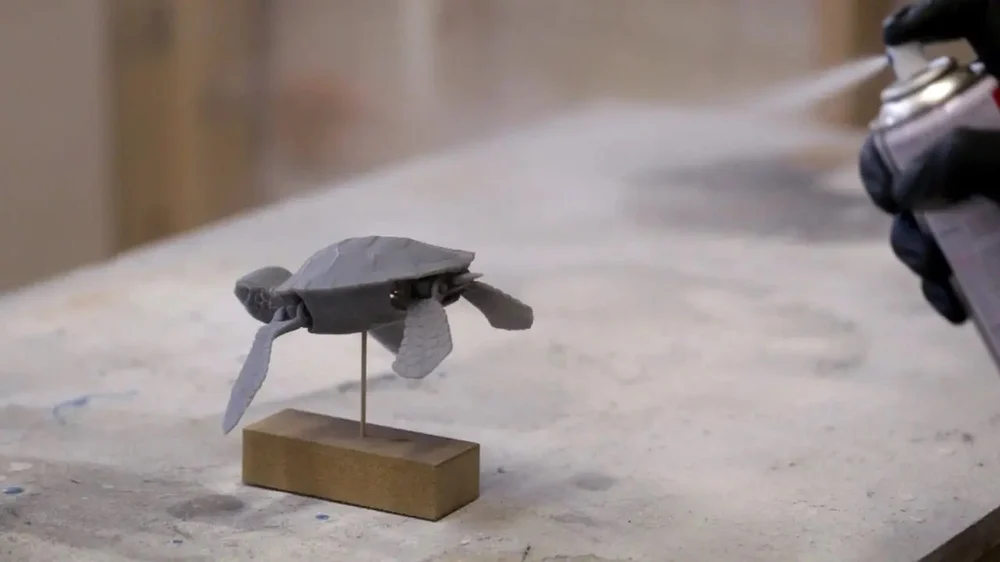
Before even getting to the paint, priming a model improves paint adhesion. Thus, whatever painting method you choose (except dyeing nylon), using primer is a good idea.
PRIMER OPTIONS
Spray primers are usually easiest to get good results: Two well-reviewed brands are Tamiya and Rust-Oleum.
METHOD
- Clean and sand your model.
- Apply the primer in thin, even coats.
- Sand after the first and last coats to get a smooth surface.
- Let each coat dry according to the primer’s specific instructions.
#1: Painting with Paintbrushes

If you paint your model with a paintbrush, it is easy to get a handmade look. This method is best for models printed in PLA, ABS, and PETG.
TIPS
- Choose a quality brush that’s stiff enough to handle the viscosity of the paint you’ve chosen to work with. The right paintbrush can move the paint where you want it to go on the surface without dragging it around too much.
- Try out a few paintbrushes first because it’s easier to get a good result with a brush that you are comfortable with. Experiment with different bristle types and handle shapes to find what works for you. We often find ourselves using only one or two different flat brushes.
- Pause your paint job to clean the brush as soon as the paint starts to dry. Of course, you should also clean it after each use. You don’t want to leave any paint drying anywhere on the bristles.
- Always store your brush after cleaning it and rest it on the handle, not the bristles.
PAINT OPTIONS
When it comes to painting with a paintbrush, you’re going to want to stick to acrylic paints.
METHOD
- Clean and sand your model.
- Apply the paint in thin, even coats.
- Allow it to dry between coats.
For a full tutorial on painting with brushes, there’s a great video from Formlabs.
#2: Painting with Aerosols
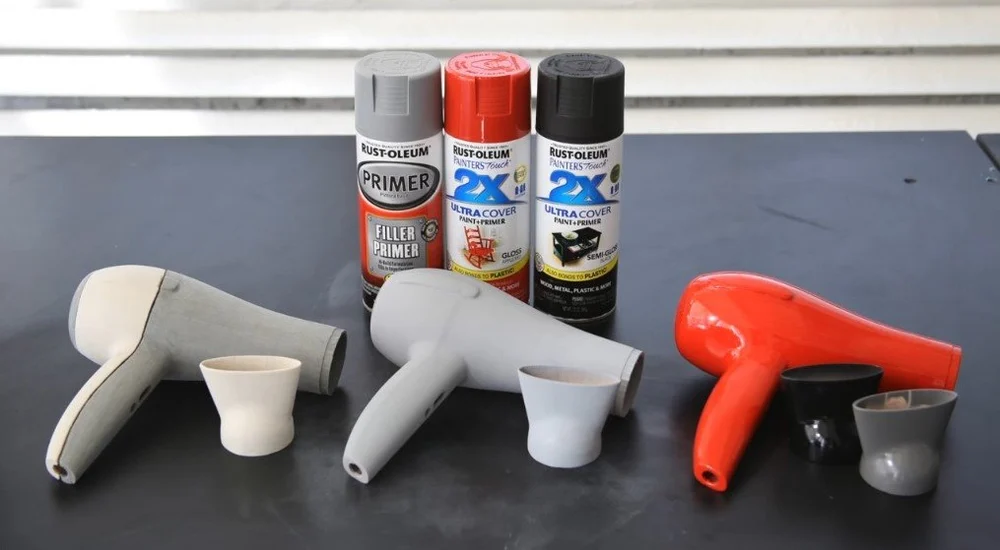
Painting with spray paints can give good results and a more uniform look. Like using a paintbrush, this method is best for models printed in PLA, ABS, and PETG.
TIPS
- Some brands’ cans offer nozzles with different characteristics, so pay attention to the differences and which you prefer.
- Shake the can before use, for as long as the manufacturer recommends. You want the paint to come out as evenly as possible.
- Keep the nozzle clean. Usually, this is done by spraying some paint with the can upside-down at the end of each session.
- Keep the can away from open flames and store it in a cool place. (It’s a pressurized container so you don’t want it getting too hot!)
PAINT OPTIONS
Searching for spray paint, you’ll find that there are many varieties available. If you’re aiming to match a particular color, be wary of the differences between the RAL, CMYK, and RGB color systems.
METHOD
- Clean and sand your model.
- Start spraying with the stream pointing slightly outside the edge of the object you want to paint.
- Apply the paint by spraying the surface you want to paint in slow, even strokes.
- Stop spraying with the stream pointing slightly outside the object you want to paint.
- Allow the paint to dry between coats.
To learn more about painting with spray paints, there’s a good overview from 3DWithUs.
#3: Dyeing (Nylon Only)
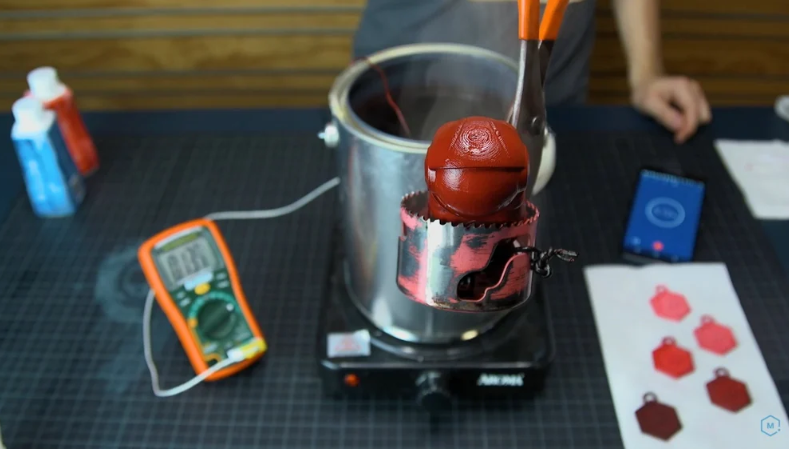
For models printed from nylon filament, instead of trying to get paint to stick on the surface, we recommend dyeing.
Note that this will not work at all on other materials. Although PLA is hygroscopic and will absorb some amount of water from its surroundings, it can’t be colored by dyeing. ABS and PETG don’t belong here either – this is a nylon special.
TIPS
- To let the dyed color show as much as possible on your nylon 3D print, you want to use a translucent or white nylon filament when 3D printing. Darker nylon filaments are also possible to dye, but the color will be much less pronounced.
- Always read the manufacturer’s instructions for your chosen dye.
- Because nylon is very hygroscopic, it absorbs water even from the open air. That’s why you should always dry your nylon filament before 3D printing. We recommend that you dye the finished model, instead of the unprinted material.
- To make sure you get the right color, you may want to try dyeing some test prints before the actual print job.
DYE OPTIONS
You have many brands of dye to choose from, but MatterHackers, for example, recommends Rit DyeMore. As long as the dye is made for synthetic fabric, like nylon, you should be fine.
METHOD
- Clean your model. If sanding, keep in mind that dyeing does not cover any scratches or marks on the surface of your model. Everything will be visible even after dyeing.
- Mix the dye with water and heat it in a pot.
- Use a thermometer to keep track of the dye temperature. Follow the manufacturer’s instructions, but keep the temperature below your filament’s heat deflection temperature.
- Tie a weight to your 3D print and submerge it in the pot with the dye.
- After dyeing, rinse well in a bath of cool water.
To learn more about how to dye your nylon prints, check out the handy guide from MatterHackers.
FAQS
Still got questions? We’ve got answers!
What Makes Paint Stick?
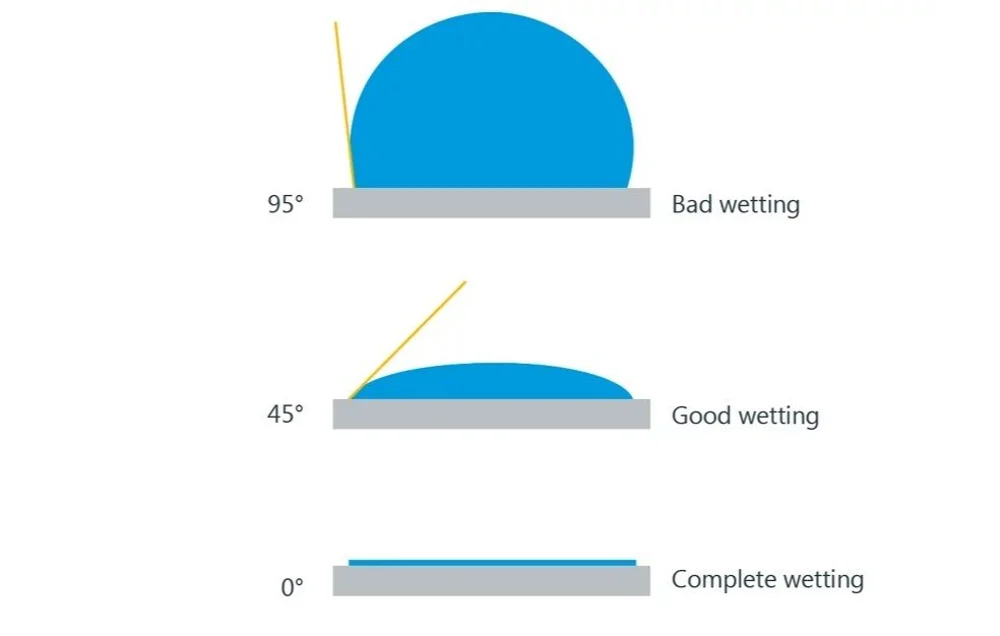
Probably the most important factor to make the paint, or any liquid substance, stick to a solid surface is the difference in surface energy between the liquid and solid. The one with the highest surface tension always wins. (Surface tension has its own unit of measurement called dynes, or dynes per square centimeter.)
The rule of thumb is that the surface tension of the paint has to be at least 10 units lower than that of the solid for good adhesion. That indicates we have a liquid with a high ability to wet the solid, and wetting is what we want.
To get a hint of how well it wets the surface you want to paint, take notice of what shape a drop of liquid forms on the solid surface:
- Apply a drop of paint or liquid on the surface you want to finish.
- If the liquid forms a ball, it has too much surface tension to effectively wet the object, and the solid will not be able to “pull” the liquid onto itself.
- If the liquid spreads out on the surface, forming something more like a lens, the wetting is better.
Can You Paint All Plastics?
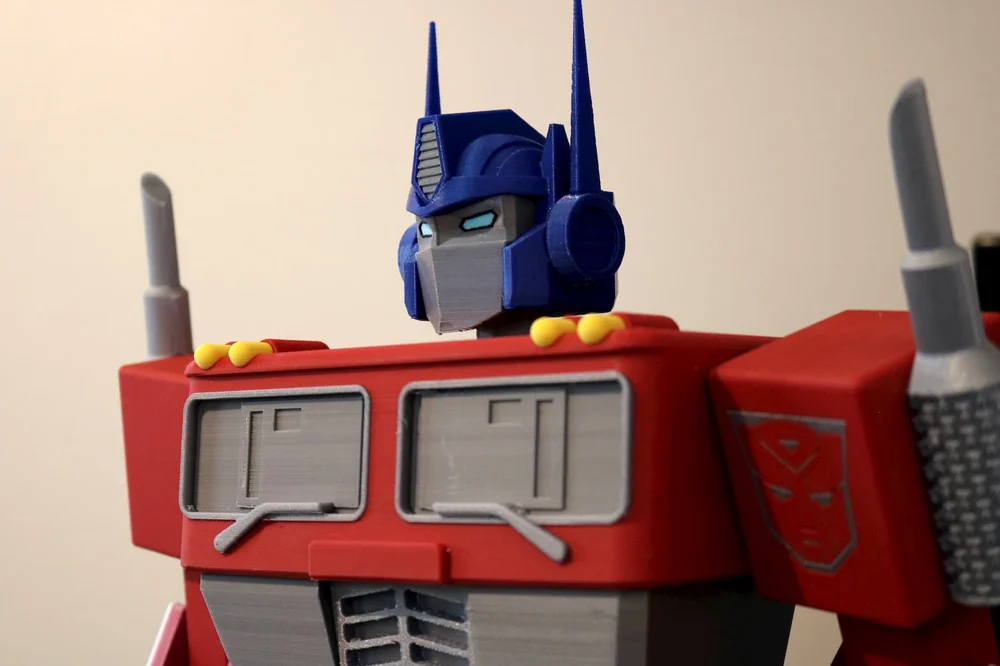
Painting FDM 3D printed models made from PLA and ABS is straightforward.
PETG, however, may be harder to paint with a durable result, but the same preparations apply as with PLA and ABS. If you really need the color to stick, we would suggest printing your PETG model in the color you want it to end up, and leave it at that.
When we’re talking about FDM 3D printed nylon, it becomes much harder to get liquids like paint to stick to the surface. It is possible to paint onto nylon, but it requires some heat treatment to maximize the surface tension and make it possible for the paint to wet. This is often done with an open flame or plasma – not something you want to do in a home environment. We believe dyeing, as described earlier, is far better for nylon.
Can You Improve Adhesion?
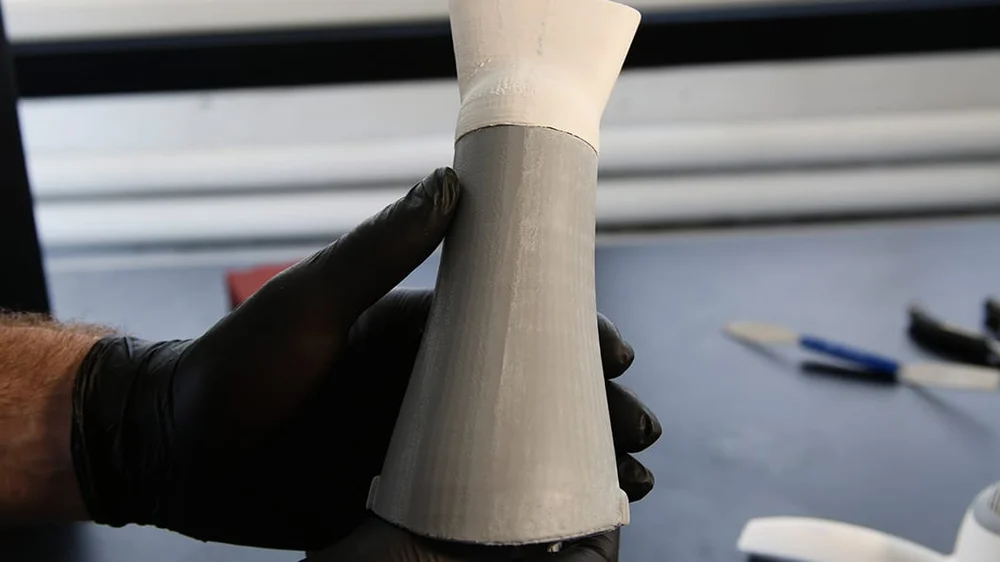
Some easy steps to enhance paint adhesion:
- Always try chemicals like paint, cleaning solvents, sanding, or other materials and methods on a test piece before moving on to the actual model you want to work on.
- Wear clean gloves when handling your 3D print, to protect your skin from chemicals and the surface of your model from skin oils.
- Remove contaminations before sanding: You don’t want to sand dirt into your model! Isopropyl alcohol (rubbing alcohol) on a lint-free, soft rag often works well for this.
- Use a vacuum cleaner with a soft and clean brush nozzle regularly to remove the sanding particles.
- Even after priming, sand the part again to eliminate any new roughness added by the primer.
How Can You Plan Ahead?

Finally, make finishing and painting a lot easier before 3D printing your model by keeping some other factors in mind:
- A lower 3D print resolution saves time in printing but adds time in finishing.
- Consider the geometry of your model. Your tools have to be able to reach the areas you want to sand or paint.
- Do the smallest details need sanding, priming, or both? If so, can they handle it without breaking?
- Primer and paint add thickness and can totally obscure smaller details on your model. On the other hand, sanding removes material and makes your model weaker.
- If dimensional accuracy is important for some parts of your 3D model, you may have to take that into account when modeling. Add some extra material to be sanded down to the right dimensions, or shrink some measurements to make room for primer and paint.